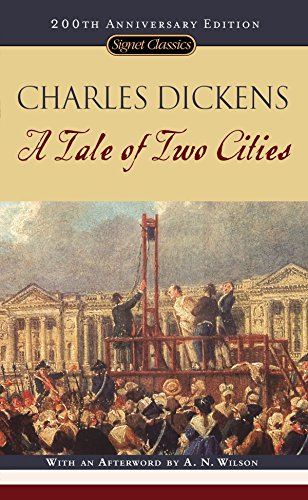
A Tale of Two Cities, other than the Bible, is probably the oldest book I have read. It was originally released a chapter at a time in a serial publication in 1859. It is broken up into three “books” and is set during the time of the French revolution. The first “book” was very captivating and well-written. The characters are not too numerous and they are described in amazing detail.
The story starts with an 18 year-old woman (Lucie) being informed that her father, whom she has never met and believed to be long dead, is alive and has been in captivity for nearly the entirety of her life. He had been held in a dark recess of Bastille and was forced to make shoes for his entire captivity. When first found, Alexandre Manette, has lost all ability to socially interact. He had previously been a physician prior to his incarceration, but no longer bears any resemblance to his former self. The author does an amazing job of describing the doctor, the place he is found, and his mannerisms. It is some of the best writing I have ever read.
The doctor is then brought back from France to England to recover. He lives with his daughter Lucie and makes very good progress at regaining his former self. Beyond the first book, the author begins adding characters without enough development and makes large jumps (five years) in the timeline. Lucie also appears to have a daughter named Lucie. It took several times of re-reading passages to distinguish the two whenever the name “Lucie” was mentioned in the second half of the book. The author makes almost no attempt to give the reader a means to distinguish the two and at first I thought “little Lucie” was a reference to Lucie in a flashback.
In the end Lucie finds a husband who is brought to trial twice and is eventually sentenced to death for being an aristocrat. At the last moment he is replaced in his jail cell by a character named Sydney Carton who has offered to die in his stead.
The first “book” is worthy of all the praise Dickens, the author, has gotten for his work. The rest I found almost unreadable. It was very difficult to finish the last two thirds of this book. The subject matter is all bleak, the characters are just tossed in, one after another, and timelines jump without reason. If this novel interests you, read the first book. Reading the rest is an exercise in endurance and painful, at best, to finish. It is a shame, because it showed so much promise for the first third.
